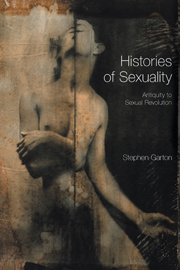Book contents
- Frontmatter
- Dedication
- Contents
- Preface
- 1 Writing Sexual History
- 2 Rule of the Phallus
- 3 Sexual Austerity
- 4 Christian Friendships
- 5 Making Heterosexuality
- 6 Victorianism
- 7 Dominance and Desire
- 8 Feminism and Friendship
- 9 Imagining Perversion
- 10 Normalizing Sexuality
- 11 Sexual Revolution
- Epilogue
- Endnotes
- Select Bibliography
- Index
6 - Victorianism
- Frontmatter
- Dedication
- Contents
- Preface
- 1 Writing Sexual History
- 2 Rule of the Phallus
- 3 Sexual Austerity
- 4 Christian Friendships
- 5 Making Heterosexuality
- 6 Victorianism
- 7 Dominance and Desire
- 8 Feminism and Friendship
- 9 Imagining Perversion
- 10 Normalizing Sexuality
- 11 Sexual Revolution
- Epilogue
- Endnotes
- Select Bibliography
- Index
Summary
Only the nineteenth century has achieved the distinction of being a ‘sexual epoch’. The Victorian era has found a central place in popular culture as a period of excessive sexual austerity, repression and prudery. In the pioneering histories of Steven Marcus, Eric Trudgill and Ronald Pearsall, Victorian sexuality was depicted as a period of Puritan moralism, an inevitable reaction against the aristocratic libertinism of the eighteenth century. Queen Victoria's insistence on propriety and respectability seemed, to nineteenth-century moral reformers and twentieth-century historians alike, to define the age that bore her name.
Victorian moral rectitude was not confined to England. These values and anxieties were shared on both sides of the Atlantic. For the early historians of Victorian sexuality, however, this was also an age of hypocrisy. Social conventions made discussion of sex, sexuality and bodily functions taboo, but at the same time pornography and prostitution flourished. For Marcus and Pearsall, the sexual puritanism of the middle classes drove sex underground, creating a split in Victorian culture. Public prudery masked a flourishing trade in vice. These historians see the new sexual morality as the creation of a sober, austere, self-controlled and frugal middle class, whose ideas gradually held sway over other classes in Britain, Europe and America. Victorianism came to dominate the ideas, habits and social conventions of the entire society but, for Marcus and others, sexual desire could never entirely be tamed. It found outlets in the flourishing vice trade.
- Type
- Chapter
- Information
- Histories of SexualityAntiquity to Sexual Revolution, pp. 101 - 123Publisher: Acumen PublishingPrint publication year: 2004



